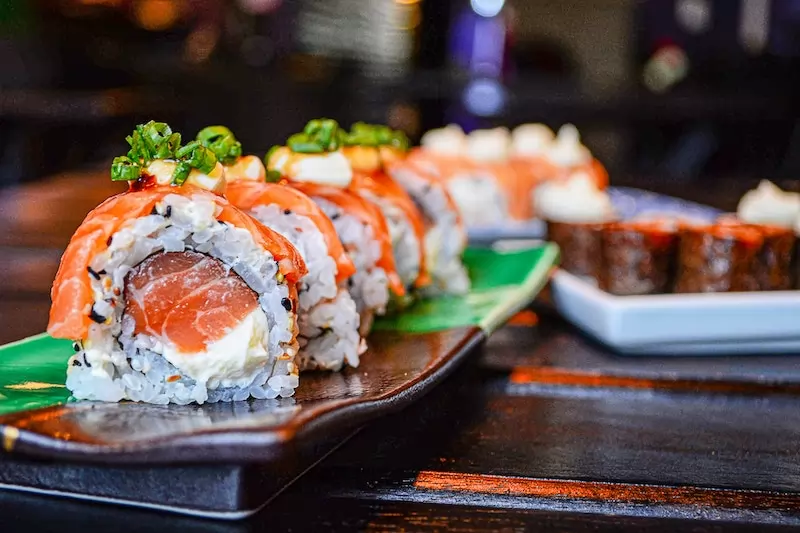Detailed content of our market study
 Inforamtion
Inforamtion
- Number of pages : 35 pages
- Format : Digital and PDF versions
- Last update :
 Summary and extracts
Summary and extracts
1 Market overview
1.1 Definition and scope of the study
Sushi is a Japanese dish made of vinegar rice (shari) and another ingredient (neta) which is usually raw fish.
There are different types of sushi, but the main ones are:
- Makis - Sushi wrapped in a roll-shaped seaweed
- Temaki - similar to maki in preparation, but shaped like a cone
- Nigiri - a slice of raw fish on an oval shaped rice ball
The global market is booming, driven by the dynamism of Japanese restaurants in all regions of the world. Growth is particularly driven by Asia and North America, which have the largest number of Japanese restaurants.
The United States has a mature market, where more than half of the population has already tried sushi. The market is growing but at a moderate pace, and the average American eats sushi 2.13 times a year. [Tastewise] Today, there are approximately 30,000 sushi restaurants in the United States.
Finally, the effect of COVID-19 on the industry is mixed; restaurants in states that have implemented mobility restrictions have suffered tremendously from declining sales.
1.2 The global market
Sushi is strongly embedded in Japanese culture, which has a positive impact on the revenues the industry generates. These revenues were slightly affected by the crisis between **** and ****, losing *% of their value (***).
Sales of sushi stores Japan, ****-****, in thousands of billion yen Source: ****
In ****, there were approximately ***,*** Japanese restaurants outside of Japan, whereas according to an NHK report shared by Forbes, the number of Japanese restaurants worldwide was **,*** in ****. The main regions for these restaurants are Asia (***). [***] There is also significant growth from **** to ****, with approximately ***,*** Japanese restaurants in ****, with the following breakdown: **% for Asia, **% for North America and *% for Europe. [***] Number of Japanese restaurants by geographic area World, ****, number of restaurants in hundreds Source: Asia Nikkei Despite the growing trend in the number of Japanese restaurants worldwide through ****, it is important to note that as we have observed in Japan, the year **** has been unprecedentedly difficult for the restaurant industry with a significant amount of restaurant closures and thus a sharp contraction in the market.
1.3 The American market
The decline in total U.S. restaurant sales in **** due to the health crisis was followed by a good recovery the two following years.
U.S. restaurant sales United States, ****-****, USD billion Source: ****
Given that the number of Japanese restaurants was around **,*** in ****, and the number of restaurant and food service establishments was ***,*** in the same year [***], assuming that the share of Japanese establishments is representative of the share of sales generated by these same restaurants, it can be estimated that the number of Japanese restaurants in the US is around **,***. If one assumes that the share of Japanese establishments is representative of the share of sales produced by those same restaurants, one can estimate that Japanese restaurants accounted for *.*% of U.S. restaurant and foodservice activity. If this share had remained the same in ****, it would be possible to give an estimate of the U.S. Japanese restaurant market of $**.* billion in ****.
Sushi restaurant market in the US United States, ****-****, in billions USD Source: ****
2 Analysis of the demand
2.1 Specificities of the American demand
The Tastewise website, which has a majority of American users, allows us to observe trends in sushi consumption in the United States. We can see that salmon is the most popular fish in terms of quantity of sushi consumed.
Top raw ingredients and combinations United States, ****, in % Source: ****
Indeed, the interest for sushi in the US follows a particular seasonality. While there is a regular peak during the month of July, there is also a very similar trend from one year to the next with a decrease in interest in the fall.
Interest for sushi search on Google United States, ****-****, in % Source: ****
Interest in sushi by State
United States, ****, in Google Trends index
Source: ****
2.2 Popularity of food delivery and take-out
The health crisis has led to an increase in the popularity of take-out food. In fact, **% of the U.S. population would have had food delivered to them by early ****. It is also interesting to note that Americans eat **% more packaged food than fresh food and that more than one in four Americans eat the same type of fastfood every day. [***]
Most popular types of takeout in the U.S United States, ****, in % Source: ****
Food delivery revenues in the United States United States, ****-****, USD billion Source: ****
3 Market structure
3.1 A dynamic sector
The number of Japanese restaurants in the US is **,*** in ****. The following graph shows that despite a small decline in **** surely related to the health crisis, the number of Japanese restaurants in the US resumed its growth from **** to exceed the **,*** restaurant mark the following year.[***] Japanese restaurants in the US United States, ****-****, in thousands of units Source: ****
Monthly new jobs in the restaurant industry United States, ****-**, in thousands Source: ****
3.2 Supply of fish used in American sushi
As we saw in the demand section, salmon and tuna are the most consumed fish in U.S. sushi restaurants.
It is possible to observe the details of the American supply of fresh or frozen salmon and tuna not intended for canning. First of all, we note that in terms of commercial fishing in the United States, the quantity of salmon caught oscillates around *** million pounds per year while tuna has stabilized slightly above *** million pounds per year.
U.S. commercial landings of non-canning fish United States, ****-****, millions of pounds Source: ****
U.S. imports of fresh and frozen fish United States, ****-****, in millions of pounds Source: ****
3.3 California rice production
Most of the rice used in sushi in the United States comes from California and more specifically from the Sacramento area.
Indeed, the rice industry in California was valued at $* billion and employed around **,*** people in ****. The president of the California Rice Commission stated that the rice in sushi consumed throughout the country systematically comes from the Sacramento Valley.
Rice produced in California is even exported to China. Indeed, California-grown rice has an excellent reputation internationally. The quality of this rice is partly due to the hard clay soil which allows the ** cm of water necessary for rice growth. The crystal clear water of the Sacramento River from the Sierra Nevada and the Mediterranean climate of the region also provide a favorable environment for grain growth. [***]
4 Analysis of the offer
4.1 Typology of the offer
In the United States, consumers have a diverse selection of sushi to choose from. Makis: sushi in the form of a roll wrapped in seaweed Temaki: similar to maki, in the form of a cone Nigiri: a slice of raw fish placed on an oval-shaped rice ball California roll : a maki that contains avocado, crab and cucumber Spring roll: filled and rolled appetizers from Southeast Asia Tataki: a slice of fish lightly cooked and marinated in vinegar Chirashi: a bowl of rice with assorted toppings Tempura : fried seafood or vegetables Although salmon and tuna are the most popular fish in sushi and sahimi dishes, there are other fish that are also commonly used. These include: Mackerel Squid Eel Crab Scallops Crayfish There also is a wide variety of fillings: Avocado Sake: salmon cut in pieces Ebi: shrimp and mayonnaise Ninjin: finely chopped carrot Kappa: cucumber (***) Kampyō: dried pumpkin strips Nattō: fermented soybeans Okra Oshinko: Takuan (***) Pickled radish Tamago omelet Tekka: tuna Tofu Ume: Umeboshi paste (***)
4.2 Average price per type of sushi
The price of sushi varies depending on the distribution channel, the type of sushi and the additional ingredient (***). In addition, restaurants usually offer platters or packages with an assortment of sushi which again increases the price range at which sushi is sold.
Sold by a chain or a supermarket kiosk, a *-pack of maki is about $* to $*.
Prices in non-chain restaurants are more difficult to evaluate. Indeed, the restaurants propose different offers (***). But we must also keep in mind that the consumer is often ready to pay more in a restaurant than in a supermarket.
There is also a strong variation in price from one region to another. Indeed, the price of sushi is a good indicator of the price of living in a city, as shown by the Sushinomics Index of Bloomberg. For example, the price of the basic roll ranged from about $** in New York to $* in New Orleans, while high-end rolls ranged from $** to $** in ****. That same year, the cities with the most expensive sushi were:
New York, NY San Francisco, CA Seattle, WA Miami, FL Los Angeles, CA
5 Regulation
5.1 Regulations concerning the sale of sushi in the United States
FDA legislation on raw fish
While the FDA does not provide specific guidance on the fish used for sushi, strict rules exist for the handling and storage of raw fish, detailed in the "Parasite Destruction Guarantee".
Following the capture of a fish, the following guidelines must be followed:
Freeze and store at room temperature at or below -**°C (***) for * days. Freeze at -**°C (***) or below for ** hours. Freeze at -**°C (***) or below for ** hours.
A sufficiently low temperature will kill any parasites living in the fish caught.
Establishments selling food must also follow the FDA's general guidelines for food labeling. [***]
OSHA Guidelines
OSHA (***) also details safety rules necessary for any restaurant aimed at, among other things:
Keeping floors clean and dry, Handle food properly, Maintaining fire safety, Maintaining optimal working conditions, Maintain age limits.
Source: ****
6 Positioning of the actors
6.1 Segmentation
- Trident Seafoods
- Pacific Seafood
- Yo! Sushi
- Wasabi
- Genji Inc.
- Benihana
- Zuma
All our studies are available online in PDF format
Take a look at an example of our research on another market!
 Choosing this study means :
Choosing this study means :
Access to more than 35 hours of work
Our studies are the result of over 35 hours of research and analysis. Using our studies allows you to devote more time and added value to your projects.
Benefit from 6 years' experience and over 1,500 industry reports already produced
Our expertise enables us to produce comprehensive studies in all sectors, including niche and emerging markets.
Our know-how and methodology enable us to produce reports that offer unique value for money.
Access to several thousand articles and paid-for data
Businesscoot has access to all the paid economic press as well as exclusive databases to carry out its market research (over 30,000 articles and private sources).
To enhance our research, our analysts also use web indicators (semrush, trends, etc.) to identify market trends and company strategies. (Consult our paying sources)
Guaranteed support after your purchase
A team dedicated to after-sales service, to guarantee you a high level of satisfaction. +44 238 097 0676
A digital format designed for our users
Not only do you have access to a PDF, but also to a digital version designed for our customers. This version gives you access to sources, data in Excel format and graphics. The content of the study can therefore be easily retrieved and adapted for your specific needs.
 Our offers :
Our offers :
the sushi market | United States
- What are the figures on the size and growth of the market?
- What is driving the growth of the market and its evolution?
- What is the positioning of companies in the value chain?
- Data from several dozen databases
5 reports pack (-15%) USA United States
- 5 reports at €75.6 excluding VAT per study to choose from our American catalogue for 12 months
- Save 15% on additional studies purchased
- Choose to be refunded any unused credit at the end of the 12-month period (duration of the pack)
See the terms and conditions of the pack and the refund of unused credit.















